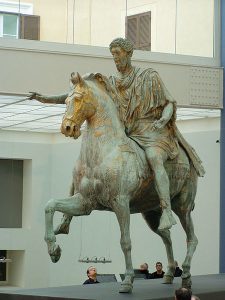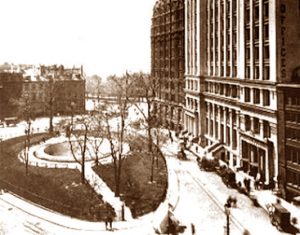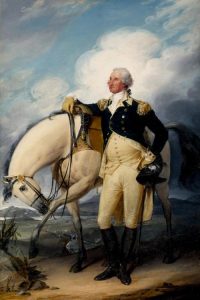On the southern tip of Manhattan Island is a small oval area called Bowling Green. On this site on March 21, 1770 a statue, sculpted by Joseph Wilton, of King George III was erected. It was commissioned on June 23, 1766 by the New York General Assembly because of “the innumerable and singular Benefits received from our most gracious sovereign, since the Commencement of his auspicious Reign, during which they have been protected from the fury of a cruel, merciless, and savage Enemy; and lately from the utmost Confusion and Distress, by the Repeal of the Stamp Act: In testimony therefore of their Gratitude, and the Reverence due to his Sacred person and Character: Resolved That this House will make Provision for an Equestrian Statue of His present Majesty, Our Most Gracious Sovereign, to be erected in the City of New York, to perpetuate to the latest posterity, the deep Sense This Colony has, of the eminent and singular Blessings derived from him, during His Most auspicious Reign.”[1] It was modeled after the famous equestrian statue of Marcus Aurelius on the Capitoline Hill in Rome.

It was the hope of Wilton that the King “would metaphorically assume and actually aspire to the wisdom and grandeur of the ancient stoic leader and thinker”[2] and become their Patriot King.[3] Lieutenant Isaac Bangs wrote a description of the statue: “Near the Fort, is the Equestrian Statue of King George … The Man is represented about 3 feet larger than a natural Man; the Horse, in proportion, both neatly constructed of Lead gilt with Gold raised on a Pedestal of White Marble, about 15 feet high, enclosed with a very elegant Fence about 10 feet high; the enclosure was oval.”[4] John Adams wrote a similar description in a letter to his wife, Abigail, after he and four delegates to the First Continental Congress visited New York City for a week.[5] Soon afterwards, a black cast-iron fence was put up around the green and atop each fence post was a decorative crown.
For ten years from 1765 to 1774, the colonists believed that all of the injustices imposed upon them from the Stamp Act up to but not including the Coercive Acts were the work of the “ministerial engine of oppression” and Parliament, but not of their King. The colonists repeatedly accused the Ministry and Parliament of misrepresenting and concealing the truth from him. However in two short years, 1774 to 1776, George III lost all of their faith and favor with the passage of the Coercive Acts, the Quebec Act, the New England Restraining Act, and the Prohibitory Act, with his refusals to redress their grievances outlined in Letters from a Farmer in Pennsylvania, the Fairfax Resolves, the Suffolk Resolves, the First Continental Congress’ Declarations of Rights and Grievances, and the Olive Branch Petition, withthe employment of German auxiliaries to fight his battles, and with his Proclamation for Suppressing Rebellion and Sedition on August 23,1775 in which he blamed the “disorderly Acts … the obstruction of lawful Commerce, and … the Oppression of Our loyal Subjects (on) … dangerous and ill-designing Men.” so much so that to him that the colonies were “in a state of open and avowed rebellion” and were “traitorously preparing, ordering, and levying War against us.”[6]
Resolves, Petitions, Remonstrances, Refusals to pay British Debts, Non-importations, Non-Consumptions, Restrained Popular Resistance – no political or economic effort made a difference. The British ministers, Parliament and the King were now in agreement and a united force. In the words of Patrick Henry, there was “no longer any room for hope.”[7]
On July 9th, 1776, seven days after its passage, Washington had the Declaration of Independence read to his troops and the citizens of New York City. After Jefferson cited 27 grievances against the king, he summarized his position in one sentence, “A Prince whose character is thus marked by every act which may define a Tyrant, is unfit to be the ruler of a free people.”[8] The fuse had been lit. “The British arms, from over the seat of justice in the Court House, … another wrought in stone, in the front of the pediment without … and the picture of King George III … in the Council Chamber, … thrown to the ground … broken into pieces … and burnt … the British arms from all the Churches in the city were ordered to be removed and destroyed.”[9]The climactic act occurred when the large crowd marched down Broadway to Bowling Green and pulled down the larger than life statue of George III.[10] Within the populace two groups were recognized for having participated in the destruction: Isaac Sears’ Sons of Liberty and Captain Oliver Brown’s soldiers (and some sailors).[11]

The statue was pulled down for two reasons: it was a symbolic act of dissolving all connection with tyrannical rule, and it was made of two tons of lead. After the statue was broken up, Captain Brown and his soldiers loaded all the pieces except the head onto wagons and headed for the wharf. The pieces were placed on a schooner that soon set sail up the East River. After the schooner reached its destination, Norwalk, Connecticut, the pieces were loaded onto oxcarts and transported to the foundry at Litchfield, Connecticut where they would be melted down and made into musket balls.[12]
The head was taken to another location. According to Captain John Montresor, a British officer, “The Rebels cut the king’s head off … cut the nose off, dipt the laurels that were wretched round his head, and drove a musket Bullet part of the way through his Head, and otherwise disfigured it … it was carried to Moore’s tavern, adjoining Fort Washington … in order to be fixed on a Spike on the Truck of that Flagstaff as soon as it could be got ready. I immediately sent Corby through the rebel Camp in the beginning of September … to [John] Cox, who kept the Tavern at King’s bridge, to steal it from thence, and to bury it, which was effected, and was dug up on our arrival, I rewarded the men, and sent the Head by the Lady Gage to Lord Townshend in order to convince them at home of the Infamous Disposition of the Ungrateful people of this distressed Country.”[13] Thomas Hutchinson, the former royal governor of Massachusetts, confirmed that the head reached England when he visited the Townshends on November 22, 1777: “Lady Townshend asked me if I had a mind to see an instance of American loyalty? And going to the sopha, uncovered a large gilt head … that of the King … The nose is wounded and defaced, but the gilding remains fair; and as it was well executed, it retains a striking likeness.”[14]
General Oliver Wolcott owned the foundry at Litchfield. Members of his family and some of his neighbors cast the melted pieces of lead into musket balls. It took one pound of lead to make 20 balls. According to the General, “an account of the number of cartridges made 42,088.”[15] The statue was estimated to weigh around two tons, but the weight of musket balls produced, at 20 to the pound, was just over one ton. Even if the estimated weight of the statue was imprecise, there was clearly a lot of lead missing, perhaps as much as a ton. What happened to all that lead?
After the lead was loaded onto oxcarts at Norwalk, the drivers did not go directly to Litchfield, but rather stopped for the night at the Clapp Raymond Tavern in Wilton, Connecticut. Living in the town were David Sloan, Jared Betts, Job Burlock, Samuel Belden who owned a nearby pond called the Davis Swamp, and number of other Tories. Unknown at the time, it appears that they had a plan to prevent as much of the lead as possible from reaching the foundry. If all but the head was loaded on the schooner in New York City and schooner made no landings between New York City and Norwalk; if all of the lead was unloaded from the schooner in Norwalk and loaded on to oxcarts; and if General Wolcott’s family and friends melted all of the lead pieces in the wagons and only were able to make 42,088 balls, the only explanation for the missing lead, as much as one ton, is that it went missing sometime overnight.
It was not until fifty years later that some of the pieces slowly began to surface. The chart below identifies what has been discovered, when, where, by whom and its current resting place.
All of the pieces in the above chart have been authenticated as being part of the statue of George III. If the head, projected to have weighed about 50 pounds, was added to the 420 pounds worth of pieces in the chart, there could still be as much as 1400 pounds of lead unaccounted for. Perhaps additional pieces remain to be found, or perhaps the statue actually weighed considerably less than the estimated two tons.

The top slab of the pedestal on which the King’s horse stood came to serve as the grave stone for Major John Smith of the Royal Highland Regiment who died July 25, 1783. After Smith’s grave was leveled in 1804, the pedestal became a stepping-stone into the kitchen at the residence of Cornelius Van Vorst. In 1818, it was moved to Van Vorst’s grandson’s residence in New York City before finally being presented to the New York Historical Society in 1874.[17]
Although the statue had been destroyed, the base survived. It was to serve as a reminder to all Americans that at one time they had been subservient to Great Britain. In 1790 John Trumbull painted a picture of the triumphant Washington at the end of the War. In the background the British are sailing out of New York harbor. Washington is in basic military dress and standing beside his horse. Also in the background near his horse’s right front leg is the statue-less pedestal. Trumbull’s symbolism was clear: one George had outlasted and vanquished the other. George Washington, not King George, was the true modern day embodiment of Marcus Aurelius – the true Patriot King.
In 1818, three years after the end of the War of 1812, the pedestal was removed forever from the Green.
[FEATURED IMAGE AT TOP: Pulling down the statue of King George III at Bowling Green, New York. Source: Wikimedia Commons]
[1] The New York Gazette, June 30, 1766.
[2] Alfred Neumeyer, “Monuments to ‘Genius’ in German Classicism,” Journal of the Warburg and Courtauld Institutes Vol. 2 (1937-39), 160.
[3] A.W. Ward and A.R. Waller, The Cambridge History of English and American Literature Vol. IX. Ch. 8 Paragraph 11, “The Idea of a Patriot King.” http://www.bartleby.com/219/0811.html
[4] Isaac Bangs, The Journal of Lieutenant Isaac Bangs, April 1 to July 29, 1776 (Cambridge: J. Wilson and Son, 1890), 25.
[5] L. H. Butterfield, ed., The Diary of John Adams, 1771-7181, Vol. 2 (Cambridge, MA: Belknap Press of Harvard University, 1961), 103.
[6] “Proclamation for Suppressing Rebellion and Sedition,” in Peter Force, American Archives, 4th Series, Vol. 3, 240.
[7] William Wirt Henry, Patrick Henry, Life, Correspondence, and Speeches, Vol. I (New York: Charles Scribner’s Sons, 1891), 262, 264.
[8] http://www.archives.gov/exhibits/charters/declaration_transcript.html
[9] Charles S. Desbler, “How the Declaration Was Received in the Old Thirteen,” Harper’s New Monthly Magazine LXXXV (July, 1892): 172.
[10] Bangs, The Journal of Lieutenant Isaac Bangs, 57; The New York Gazette, July 22, 1776.
[11] Pennsylvania Journal and The Weekly Advertiser, July 17, 1776; Horace Edwin Hayden, A Biographical Sketch of Captain Oliver Brown (Wilkes-Barre, PA: Privately Printed, 1882), 10.
[12] A. J. Wall, “The Statues of King George III and the Honorable William Pitt Erected in New York City 1770,” New York Historical Society Quarterly Bulletin, Vol. IV, 1920, 47, 50-2.
[13] “Journals of Capt. John Montresor, 1757-1778,” in Collections of the New-York Historical Society for the Year 1881, Vol. XIV (New York: Printed for the Society, 1882), 123-24. Montresor wrote this after the British retook New York City in September 1776.
[14] Peter Orlando Hutchinson, Diary and Letters of His Ex. Thomas Hutchinson Vol. 2 (London: S. Low, Marston, Searle & Rivington, 1886), 167.
[15] George C. Woodruff, The History of the Town of Litchfield, Connecticut
(Litchfield: Charles Adams, 1845), 46.
[16] “King George’s Head,” Sons of the American Revolution (Winter 1998), http://connecticutsar.org/king-georges-head/
[17] Wall, “The Statues of King George III,” 54.














4 Comments
It’s always enjoyable to read an article that brings Revolutionary War history to the present by pointing out locations of sites and artifacts. The Statue of King George being pulled down is an iconic image known to many. It was even a Jeopardy question several years ago. I especially enjoyed the chart of existing parts of the statue but found the URL citation led to a broken link. I believe the citation is http://connecticutsar.org/king-georges-head/. Thanks for the read.
The link in the citation has been fixed. Good catch, SPM!
I am preparing a paper for the Fields of Conflict 2016 in Dublin, Ireland on the statue of King George III that was converted into 42,088 musket balls. I have seen several articles including this one in your magazine on the “missing lead”. I might have an idea about that. The statute is reported to be estimated at about 4000 pounds. Ruppert reports that at 20 to the pound, that would only equal 2104 lbs of lead. This however is a 0.61″ diameter ball (Sivilich Formula) – pretty small. Do we know what guns were being used in 1776? There may have been a number of old Committee of Safety Brown Bess muskets which took a 0.69″ ball. This would yield 2784 lbs. Where is the rest? Michael Seibert (NPS archaeologist) and I had the opportunity to analyze the pieces in the New York Historical Society and we found the statute was on an iron armature. Rather large “rebar” was in the appendages and iron mesh for the body. This armature could be another 1000 lbs. This would indicate that there are little if any large pieces still out there.
Re-reading Joy Day Buel & Richard Buel’s wonderful THE WAY OF DUTY, I find that the small son of Gold Selleck Silliman traveled to New York in April, 1776, and later wrote to his grandparents:
“… and I saw the kings statue, and he sat on a great Horse, both covered over with leaf Gold, and the King had one bullet hole through his cheek, and another through his neck, and they talk of running his Majesty up into Bullets for he and his horse are made of lead. The houses most all join together; and I never see such a fine place in my life…”
I have not read this detail of vandalism elsewhere, and thought others might be interested.